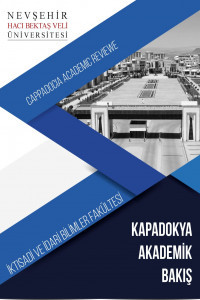HİTİT-MISIR BARIŞ ANTLAŞMASININ ARDINDAN İKİ DEVLET ARASINDA YÜRÜTÜLEN İLİŞKİLER ÜZERİNE KISA BİR DEĞERLENDİRME
M.Ö. ikinci binde Anadolu’da siyasi birliği sağlayarak zamanla imparatorluk haline gelen Hititlerin Eski Çağ tarihindeki yeri oldukça önemlidir. Siyasi hamleleri ile Yakın Doğu politikasına bir dönem oldukça etkileyen Hititler, bölgedeki birçok devlet ile siyasi ekonomik ve kültürel ilişki kurmuştur. Bu devletlerin en önemlilerinden biri ise Kadeš’te savaştığı ve ardından daha önce örneği görülmemiş bir barış ve müttefiklik anlaşmasına imza attığı, Mısır Devletidir. Savaşın ardından neredeyse on altı yıl sonra gerçekleştirilen o döneme kadar benzeri görülmemiş eşitlik ve barış anlaşması sonrasında, Hitit ve Mısır hanedanlıkları arasında önemli bir diplomatik ağ gelişmiştir. İki devlet arasındaki bu diplomatik ağ, Hitit başkenti Boğazköy'de açığa çıkarılan arşivlerden görülebilmektedir. Hitit ve Mısır arasındaki bu yazışmalar, Tunç Çağı devletlerarası diplomasisinin tipik bir örneği olarak karşımıza çıkmaktadır. Hitit ve Mısır arasında kurulan bu ilişki, bölgenin güçler dengesini korumak ile kalmamış aynı zamanda hükümdarların da kişisel meşruiyetlerini güçlendirebilmeleri açısından önemli olmuştur.
Anahtar Kelimeler:
Hitit, Mısır, Bronz Çağı, Mektuplaşma
A BRIEF EVALUATION ON THE RELATIONS BETWEEN THE TWO STATES AFTER THE HITITITE-EGYPT PEACE TREATY
ABSTRACT
The Hittites became an empire in time by ensuring the political unity of the Anatolia in the Second Millennium BCE. This civilization had marked the Near Eastern politics in its time by using successful tactical and political movements. One of the most important aims of the Hittite state within the framework of maintaining and growing its existence, was to improve its audit sphere on Syria, and to use the economic and strategic advantages of the region. Due to this policy; the interests of the Hittite State had conflicted with the other states who also tried to create their own audit sphere on the region. One of the most important of these states was Egypt whom Hittites fought against in Kadesh and created an unprecedented peace alliance. In the aftermath of the unprecedented equality and peace agreement, concluded almost 16 years after the war, a significant diplomatic network developed between the Hittite and Egyptian empires. This diplomatic network between the two states can be seen in the archives unearthed in the Hittite capital, Boğazköy. These diplomatic correspondences between Hittite and Egypt appear as a typical example of Bronze Age interstate diplomacy. The established relationship between Hittite and Egypt was important not only to maintain the balance of power in the region, but also to strengthen the personal legitimacy of the rulers.
Keywords:
Hittite, Egypt, Bronze Age, Correspondence,
___
- Alp, S.(2000) Hitit Çağında Anadolu, Ankara: TÜBİTAK.
- Alp, S. (2001) Hitit’lerin Mektuplaşmaları, İstanbul, Eskiçağ Bilimleri Enstitüsü Yayınları.
- Altman A.( 2003) “Rethinking the Hittite System of Subordinate Countries from the Legal Point of View”, JAOS Col 123 no 4, s. 741-756.
- Beckman G. (1996) Hittite Diplomatic Texts, Atlanta-Georgia.
- Bryce, T. (2003) Letters of the Great Kings of the Ancient Near East, New York.
- Cochavi-Rainey, Z. (1999) ‘Royal Gifts in the Late Bronze Age’. Fourteenth to Thirteenth Centuries B.C.E. Selected Texts Recording Gifts to Royal Personages,” Beer-
- SheevaVol XIII, Beer-Sheba: Ben-Guryon University of the Negev Press.
- Darga M. (2013) Anadolu’da Kadın: On Bin Yıldır Eş, Anne, Tüccar Kraliçe, Yapı Kredi Yayınları, İstanbul.
- Edel E. (1994), Die Ägyptisch-hethitische Korrespondenz aus Boghazköy (Bd I Umschriften und Übersetzungen; Bd II Kommentar), Opladen (cited as ÄHK).
- Gabolde, M. (1998), D’Akhenaton à Toutânkhamon, Lyon.
- Hagenbuchner, A. (1989), Die Korrespondenz der Hethiter (2 Parts), Heidelberg.
- Harris M. (1988) Culture, People, Nature: An Introduction to General Anthropology, New York.
- Hoffner, H. A. (2009), Letters from the Hittite Kingdom, Society of Biblicle Literature, Atalanta.
- Karauğuz G. (2019) Hititlerde haberleşme Diplomatik Muharebat ve Diğer Kil Mektuplar, Çizgi Kitabevi, Konya.
- KBo Keilschrifttexte aus Boghazköi. Leipzig – Berlin
- KUB Keilschrifturkunden aus Boghazköi. Berlin
- Laroche, E. (1971) Catalogue des textes Hittites. (CTH) Paris: Klincksieck,
- Liverani M.(2001) International Relations in the Ancient Near East 1600-1100 BC., Palgrave Mcmillian, Italy.
- Meier S.A. (2000) “Diplomacy and International Marriage”, Amarna Diplomacy: The Beginnings of International Relations, Baltimore-Maryland.
- Moran W. L. (1992) The Amarna Letters, Baltimore-Maryland.
- Sadowska, M. (2000), ‘Semenkhkare and Zananza’, Göttinger Miszellen 175, 73–77.
- Podany A. H. (2010) Brotherhood of Kings: How International Relations Shaped the Ancient Near East, Oxford University Press.
- Schulman A. R. ( 1979) “Diplomatic Marriage in the Egyptian New Kingdom”. JNES 38, Chicago, 1979, s. 179.
- Singer, I.(2002) “La Siria dopo la battaglia di Qadesh,” La Battaglia di Qadesh: Ramesse II contro gli Ittiti per la conquista della Siria, Sillabe.
- Sürenhagen, D.(2006) “Forerunners of Hattusili-Ramesses Treaty”, BMSAES, Ekim, 6. Sayı, 2006, s. 59-67.
- https://www.hethport.uni-wuerzburg.de/CTH/
- https://www.hethport.uni-wuerzburg.de/hetkonk/hetkonk_abfrage.php?c=171
- https://www.hethport.uni-wuerzburg.de/CTH/index.php?l=Pudu%E1%B8%ABepa
- https://www.hethport.uniwuerzburg.de/hetkonk/hetkonk_abfrage.php?c=169
- https://www.hethport.uni-wuerzburg.de/hetkonk/hetkonk_abfrage.php?c=165
- ISSN: 2602-3474
- Yayın Aralığı: Yıllık
- Başlangıç: 2017
- Yayıncı: Nevşehir Hacı Bektaş Veli Üniversitesi
